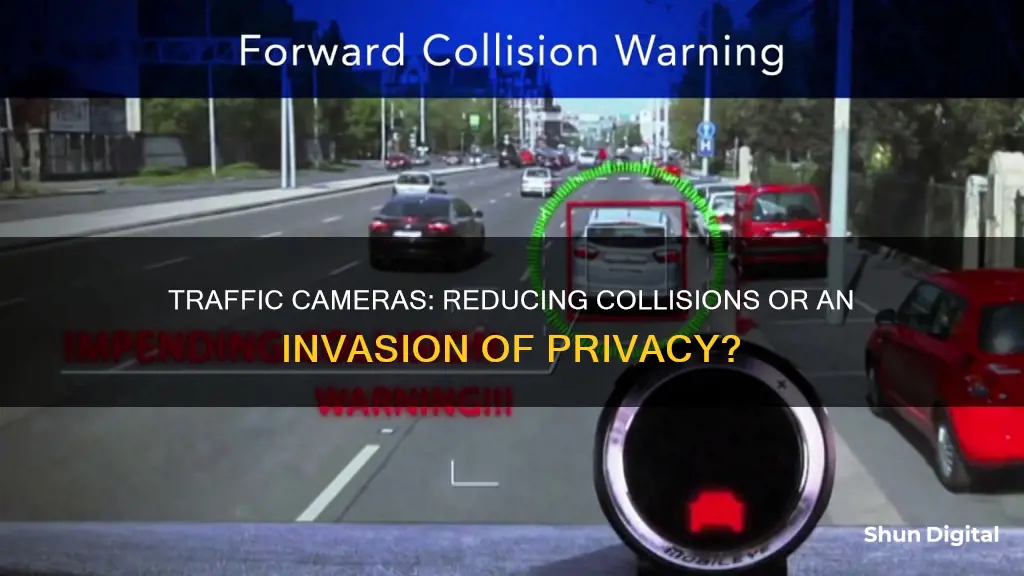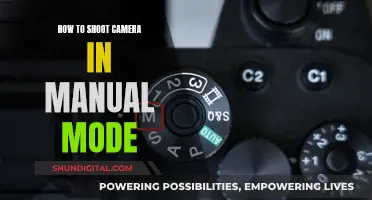
Traffic cameras are a controversial topic, with some arguing that they improve road safety by reducing speeding and others claiming that they are ineffective or even counterproductive. While some studies suggest that speed cameras can reduce the number of road collisions and related casualties, others indicate that they may increase accidents, particularly rear-end collisions. The placement or removal of speed cameras does not appear to independently affect the incidence of motor vehicle collisions. However, speed cameras are theoretically valuable as they have the potential to reduce velocity, which contributes significantly to kinetic energy and the severity of collisions.
| Characteristics | Values |
|---|---|
| Are traffic cameras preventing collisions? | The evidence is mixed. Some studies show a reduction in collisions, while others show an increase or no change. |
| Factors influencing effectiveness | - Type of camera (static or mobile) |
- Location criteria
- Use of educational initiatives alongside enforcement
- Long-term effects | | Limitations of studies | - Lack of control groups or adequate control for potential confounders
- Short study periods | | Benefits of traffic cameras | - Reduced speed limits
- Decreased number of vehicles running red lights | | Drawbacks of traffic cameras | - Increased fear of fines, leading to more sudden stops and rear-end accidents
- Potential for drivers to ignore tickets |
What You'll Learn

Speed cameras may reduce collision severity but not incidence
Speed cameras are controversial in the United States, despite being considered valuable in theory. They are one of the tools used to enforce lower speeds, with the aim of reducing the number of road collisions and their consequences.
While speed cameras have been shown to reduce the severity of collisions by reducing the speed of vehicles, there is less evidence to suggest that they reduce the incidence of motor vehicle collisions. A study in Arizona found that the placement or removal of speed cameras on a 26-mile segment of highway did not affect the number of motor vehicle collisions. However, the same study also noted that there are very few studies examining the effect of speed cameras on motor vehicle collisions in the US.
On the other hand, a study in Barcelona, Spain, found that speed cameras were effective in reducing the number of road collisions, and consequently, the number of injured people and vehicles involved in collisions. The protective effect of speed cameras was more pronounced during weekend periods and at night.
A systematic review of 14 observational studies also concluded that speed cameras are effective in reducing road traffic collisions and related casualties. However, the level of evidence was considered relatively poor due to a lack of satisfactory comparison groups and adequate control for potential confounders.
While speed cameras may not directly reduce the incidence of collisions, they can play a role in road safety by reducing the severity of crashes when they do occur. Further studies are needed to fully understand the impact of speed cameras on road safety.
Audio Surveillance in South Carolina: What's the Law?
You may want to see also

Cameras can increase accidents from stopping at red lights
While red light cameras are intended to improve road safety, they can have the unintended consequence of increasing accidents from stopping at red lights. This is due to the fear of fines causing more sudden stops and rear-end collisions.
A study of three large Texas cities over a 12-year period found no evidence that red light cameras improve public safety. When Houston's camera program was discontinued in 2010, angle accidents (those caused by vehicles running red lights) increased by 26%, but all other types of accidents decreased by 18%. This suggests that any benefits of the cameras were cancelled out by their drawbacks.
Media reports from various US cities also indicate an increase in accidents at intersections with red light cameras. For example, a local TV station in Los Angeles found that accidents increased at 20 out of 32 intersections studied, with several intersections tripling their accident rate. Similarly, reports from Washington, D.C., showed a 107% overall increase in accidents at red-light camera intersections.
While red light cameras can reduce the number of vehicles running red lights, they may also lead to an increase in rear-end accidents as drivers suddenly stop to avoid a fine. This trade-off between different types of accidents should be carefully considered when evaluating the overall effectiveness of red light camera programs.
Mastering Auto Focus for Cinematic Camera Work
You may want to see also

Speed cameras can be effective in urban settings
Another study in Arizona examined the effects of speed cameras on a 26-mile segment of interstate I-10 in urban Phoenix. The cameras were placed every 2 miles along the segment, and a 14-mile segment without cameras was used as a control. The results showed a 1.5% increase in motor vehicle collisions (MVC) when cameras were present and a 28% increase when cameras were removed. However, after accounting for MVC increases in the control segment, it was found that neither the placement nor the removal of speed cameras had an independent impact on MVCs.
While the effectiveness of speed cameras in reducing collisions may vary depending on the specific context and location, they can be a valuable tool in urban settings to encourage drivers to adhere to speed limits and potentially reduce the severity of collisions.
Setting Up Spy Cameras: Computer Connection Guide
You may want to see also

Cameras are controversial in the US
Further controversy arises from the mixed evidence of their effectiveness. While some studies have shown a reduction in collisions, others have shown an increase, or no impact at all. For example, a study in Barcelona found a 27% decrease in collisions, while a study in Arizona showed a 1.5% increase in collisions when cameras were installed.
The implementation of speed cameras is also controversial due to their cost to taxpayers and the belief that they impede officers from performing their jobs effectively. The removal of cameras in Arizona in 2010 was likely due to these controversies and political reasons.
Despite the controversies, the theoretical value of speed cameras is still considered high. By reducing vehicle speed, they can potentially lower the severity of collisions and the resulting injuries. Further studies are needed to fully understand the effects of speed cameras on collision incidence and injury severity.
How Masking in Adobe Camera Raw Transforms Photos
You may want to see also

Camera placement can affect collision rates
Camera placement can have a significant impact on collision rates, as evidenced by studies and reports from various cities. The placement of cameras at specific locations and angles can influence driver behaviour and, consequently, the incidence of accidents.
In Phoenix, Arizona, a study was conducted to examine the effects of speed cameras on a 26-mile segment of interstate I-10. The results indicated a slight increase in motor vehicle collisions (MVC) when cameras were installed, with a more significant increase observed after the cameras were removed. This suggests that camera placement may have had a mitigating effect on collisions, but the overall impact was not substantial.
In contrast, a study in Barcelona, Spain, found that speed cameras installed on the city's beltway effectively reduced road collisions. The relative risk of a collision occurring on the beltway after the installation of speed cameras decreased by 27%. This protective effect was more pronounced during weekend periods. However, no significant differences were observed on arterial roads without fixed speed cameras.
The impact of camera placement is further highlighted by reports from various US cities. For instance, a local TV station in Los Angeles fact-checked the city's claims about accident reduction and discovered that accidents had increased at 20 out of 32 intersections studied, with several intersections experiencing a tripling of their accident rate. Similarly, reports from Washington, D.C., Portland, Oregon, and Fort Collins, Colorado, all indicated significant increases in accidents, particularly rear-end crashes, following the installation of red-light cameras.
The mixed results regarding the effectiveness of cameras in reducing collisions suggest that camera placement and other factors play a crucial role. The angle, location, and type of camera (static or mobile) can all influence driver behaviour and the overall safety of an intersection or highway segment.
Low Power Mode: Impact on Camera Performance
You may want to see also
Frequently asked questions
Research shows that traffic cameras are effective at reducing the number of vehicles running red lights or speeding. However, conflicting evidence suggests that they may not reduce the total number of accidents, as drivers may be more inclined to perform sudden stops, leading to an increase in rear-end accidents.
Traffic cameras can reduce the severity of collisions by lowering the speed of vehicles. This reduction in speed lowers the kinetic energy transferred to the vehicle's occupants, which is the main mechanism for injury.
No, a study in Barcelona found that speed cameras reduced the number of road collisions, injured people, and vehicles involved in collisions. The protective effect of speed cameras was greater during the weekend.







